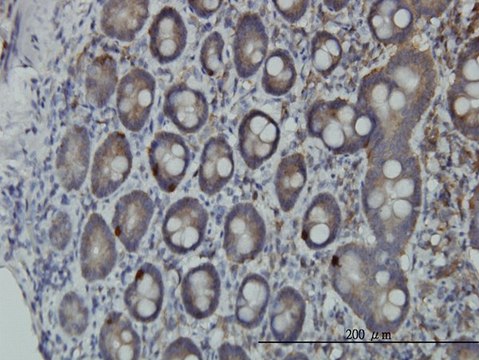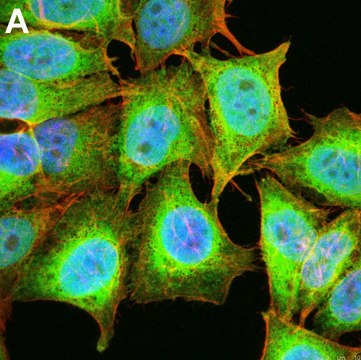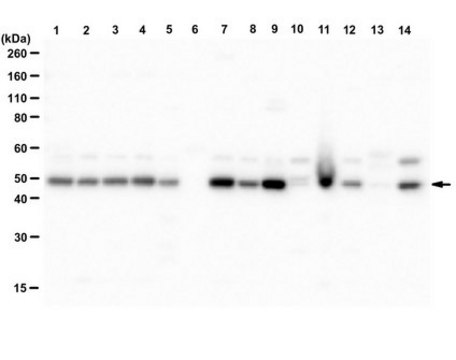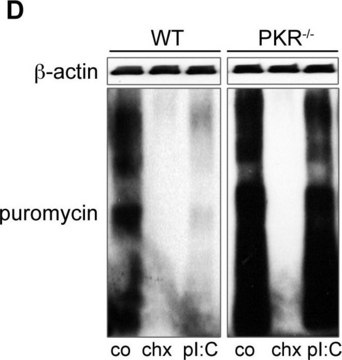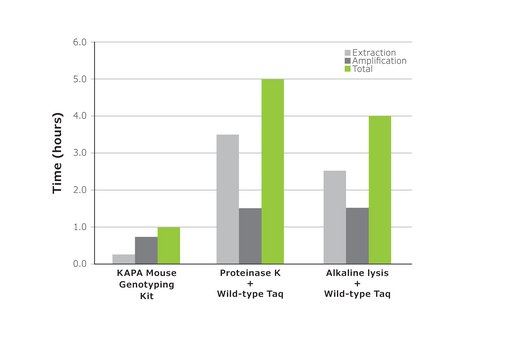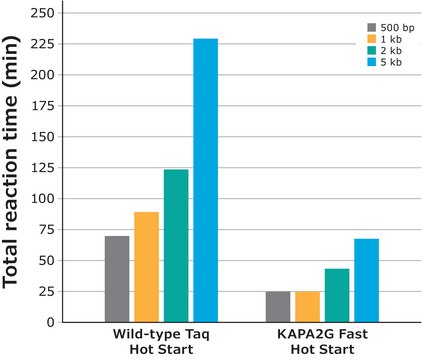AB10553
Anti-Prohormone Convertase PC1/PC3 Antibody
from rabbit, purified by affinity chromatography
Sign Into View Organizational & Contract Pricing
All Photos(2)
Synonym(s):
NEC 1, Prohormone convertase 1, Proprotein convertase 1, neuroendocrine convertase 1, prohormone convertase 3, proprotein convertase subtilisin/kexin type 1
UNSPSC Code:
12352203
eCl@ss:
32160702
NACRES:
NA.41
Recommended Products
biological source
rabbit
antibody form
affinity isolated antibody
antibody product type
primary antibodies
clone
polyclonal
purified by
affinity chromatography
species reactivity
mouse, human, rat (97%)
species reactivity (predicted by homology)
dog (97%), pig, bovine (95%), ape (97%)
technique(s)
immunocytochemistry: suitable
immunohistochemistry: suitable
western blot: suitable
NCBI accession no.
UniProt accession no.
shipped in
wet ice
Gene Information
chimpanzee ... Pcsk1(461740)
human ... PCSK1(5122)
General description
The protein encoded by this gene belongs to the subtilisin-like proprotein convertase family. The members of this family are proprotein convertases that process latent precursor proteins into their biologically active products. This encoded protein is a type I proinsulin-processing enzyme that plays a key role in regulating insulin biosynthesis. It is also known to cleave proopiomelanocortin, prorenin, proenkephalin, prodynorphin, prosomatostatin and progastrin. Mutations in this gene are thought to cause obesity. This encoded protein is associated with carcinoid tumors. The use of alternate polyadenylation sites has been found for this gene. Multiple alternatively spliced transcript variants have been described for this gene but their full length nature is not known.
Specificity
This antibody recognizes Prohormone Convertase PC1/PC3.
Immunogen
Epitope: Mature Chain
This antibody is generated from rabbits immunized with a KLH conjugated linear peptide within human Prohormone Convertase PC1/PC3.
Application
Anti-Prohormone Convertase PC1/PC3 Antibody is an antibody against Prohormone Convertase PC1/PC3 for use in WB, IC, IH.
Immunocytochemistry Analysis: 1: 500 dilution from a previous lot detected Prohormone Convertase PC1/PC3 in HeLa, C2C12, NIH/3T3 cell lysates.
Research Category
Neuroscience
Neuroscience
Research Sub Category
CNS Control of Metabolism
CNS Control of Metabolism
Quality
Evaluated by Western Blot in mouse adrenal gland tissue lysate.
Western Blot Analysis: : 0.5 µg/mL of this lot detected Prohormone Convertase PC1/PC3 on 10 µg of mouse adrenal gland tissue lysate.
Western Blot Analysis: : 0.5 µg/mL of this lot detected Prohormone Convertase PC1/PC3 on 10 µg of mouse adrenal gland tissue lysate.
Target description
Observed at 95 KDa because of multiple glycosylation.
Physical form
Affinity purified
Rabbit polyclonal serum in buffer containing 0.1 M Tris-Glycine (pH7.4) 150 mM NaCl with 0.05% sodium azide.
Storage and Stability
Maintain refrigerated at 2-8°C for up to 12 months.
Analysis Note
Control
Mouse adrenal gland tissue lysate
Mouse adrenal gland tissue lysate
Disclaimer
Unless otherwise stated in our catalog or other company documentation accompanying the product(s), our products are intended for research use only and are not to be used for any other purpose, which includes but is not limited to, unauthorized commercial uses, in vitro diagnostic uses, ex vivo or in vivo therapeutic uses or any type of consumption or application to humans or animals.
Certificates of Analysis (COA)
Search for Certificates of Analysis (COA) by entering the products Lot/Batch Number. Lot and Batch Numbers can be found on a product’s label following the words ‘Lot’ or ‘Batch’.
Already Own This Product?
Find documentation for the products that you have recently purchased in the Document Library.
TAT-mediated transduction of MafA protein in utero results in enhanced pancreatic insulin expression and changes in islet morphology.
Vargas, N; Alvarez-Cubela, S; Giraldo, JA; Nieto, M; Fort, NM; Cechin, S; Garcia et al.
Testing null
Maria C Ferreira Dos Santos et al.
Nature communications, 11(1), 296-296 (2020-01-17)
Regulation of cellular iron homeostasis is crucial as both iron excess and deficiency cause hematological and neurodegenerative diseases. Here we show that mice lacking iron-regulatory protein 2 (Irp2), a regulator of cellular iron homeostasis, develop diabetes. Irp2 post-transcriptionally regulates the
Xiaoyi Ma et al.
The Journal of endocrinology, 246(3), 223-236 (2020-07-23)
The angiotensin-converting enzyme 2 (ACE2)/angiotensin 1-7 (A1-7)/MAS axis and glutamate decarboxylase 67 (GAD67)/gamma-aminobutyric acid (GABA) signal both exist in the islet and play important roles in regulating blood glucose metabolism. It has been reported that the activation of ACE2 in
Charting a high-resolution roadmap for regeneration of pancreatic I? cells by in vivo transdifferentiation from adult acinar cells.
Liu, et al.
Science Advances, 9, eadg2183-eadg2183 (2023)
Divya P Kumar et al.
The Journal of biological chemistry, 291(13), 6626-6640 (2016-01-14)
The physiological role of the TGR5 receptor in the pancreas is not fully understood. We previously showed that activation of TGR5 in pancreatic β cells by bile acids induces insulin secretion. Glucagon released from pancreatic α cells and glucagon-like peptide
Our team of scientists has experience in all areas of research including Life Science, Material Science, Chemical Synthesis, Chromatography, Analytical and many others.
Contact Technical Service